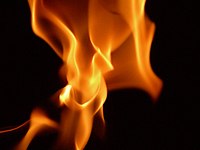
Photo from wikipedia
Inverse diffusion flame (IDF) is an effective and widely used reaction form in the process of noncatalytic partial oxidation (NC-POX) of gaseous hydrocarbons (such as natural gas and coke oven… Click to show full abstract
Inverse diffusion flame (IDF) is an effective and widely used reaction form in the process of noncatalytic partial oxidation (NC-POX) of gaseous hydrocarbons (such as natural gas and coke oven gas). However, soot is generated in the combustion chamber in the case of unreasonable feeding conditions, and thus causes serious damage to the wall and nozzle. In this study, the effects of the equivalence ratio ([O/C]e), the oxygen flow rate, and the Reynolds number on the soot and CH* emission characteristics of CH4/O2 inverse diffusion flame were comprehensively analyzed based on a hyperspectral imaging system. In addition, the relationship between CH* and soot is explored using Ansys Fluent simulation. The experimental results show that the soot radiation core generation area is located in the outer ring of the flame, and the radial distribution of the radiation intensity is bimodal. With the increase in [O/C]e, the initial position for soot radiation and the overall radiation intensity of soot decrease. In addition, the CH* radiation intensity decreases as [O/C]e increases, and CH* exists in the whole flame. The simulation results clearly show that the existence of CH* is conducive to soot production. The emission intensity and the core area of soot formation increase with the increase in the oxygen velocity. Additionally, the soot emission region increases and the flame tip changes from a round blunt to symmetrical tip with the increase in the Reynolds number.
Journal Title: ACS Omega
Year Published: 2021
Link to full text (if available)
Share on Social Media: Sign Up to like & get
recommendations!